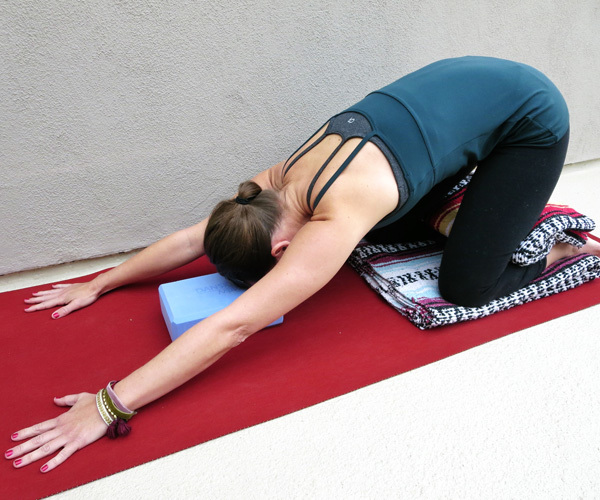"Be kind to your knees. You'll miss them when they're gone."
http://www.teambeachbody.com/teambeachbodyblog/fitness/8-yoga-moves-to-strengthen-knees?referringRepId=28870
Yoga can be daunting for those with knee problems. Unfortunately, that’s a lot of us, myself included. Below are the yoga poses I used to strengthen my knee after surgery.
Three years into my yoga career, I suffered a meniscus tear. Physical therapy, ice, and painkillers were not enough to ward off surgery. I had to go under the knife.
My bones and tendons blocked the doctors from seeing the exact location of the tear in ultrasounds, so exploratory surgery had to be performed before the surgeon could fix the problem. By the time they were done, my leg looked like it had been beaten with a meat tenderizer and my muscles and soft tissue were in a sorry state. Giving up my career as a yoga instructor was not an option for me, so I took the time to learn how to protect my knee by strengthening the muscles that support it.
Here are the exact poses I practiced to strengthen and stretch my knees. However, make sure to
always seek advice from your physician before beginning any exercise or rehabilitation regimen, especially if you have any unique or special medical conditions, such as knee problems.
5 Knee-Strengthening Poses:
Supported Chair Pose (Utkatasana) This pose will strengthen the quadriceps, hamstrings, and abductors. It also increases blood flow to the lower region of the body, which can help with fluidity of movement. Chair pose is typically practiced away from the wall, but that may require more strength than your knees are able to handle at the moment, so use the support of a wall if you need it. Place your feet hip distance apart. Lean your back up against a wall and slide down until your knees and ankles are parallel with each other. You can place your hands on your thighs or reach the arms towards the ceiling. Hold the pose for a few breaths then slide back up. Repeat several times. As your legs get stronger, increase the number of breaths you hold the pose.
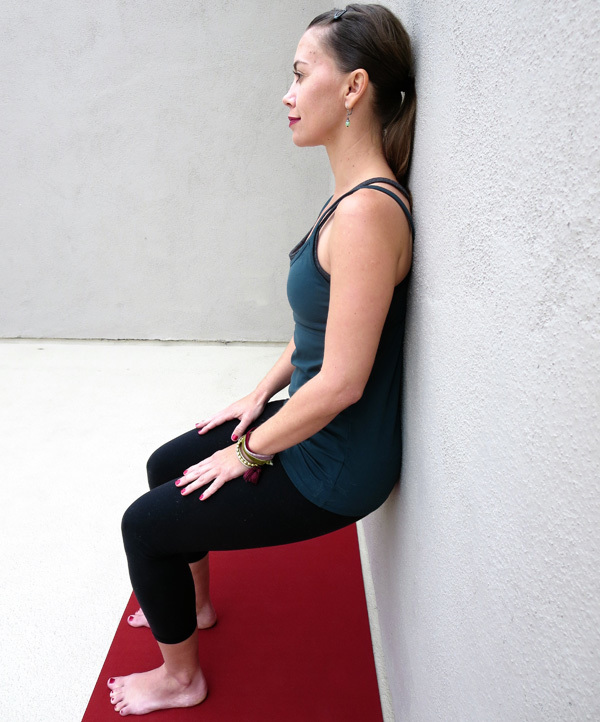 Supported Bridge Pose (Setu Bandasana)
Supported Bridge Pose (Setu Bandasana) Bridge pose is a yoga asana that helps properly align your knees while strengthening your back, glutes, and hamstrings. Lie flat on your back with your knees bent and walk your feet towards your bottom until you can just touch your heels with your fingertips. Step your feet out hip distance apart and place a block horizontally on the floor between your feet. This will help keep everything in place. Press into all four corners of the feet, the inside and outside edges as well as the heel and the balls. Draw your navel in toward your spine and press your lower back into the ground. Tuck your tailbone in and lift your bottom from the ground. Lift as high as you can without compromising your form (your knees should remain hip distance apart and parallel with the ankles). To get an added stretch in the chest, you can roll your shoulders under your body and interlace your fingers underneath you. Hold this pose for a few breaths then release the upper back first, then mid back, then finally lower your lower back and tailbone to the floor. Repeat a few times.
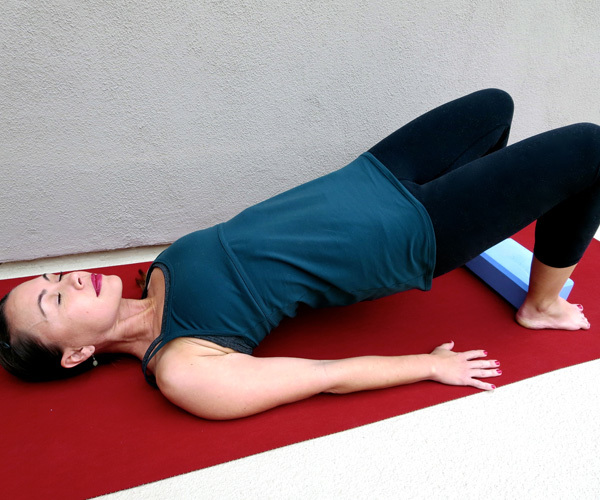 Supported Half Moon Pose (Ardha Chandrasana)
Supported Half Moon Pose (Ardha Chandrasana) Balancing poses can be very beneficial when it comes to building the muscles that help the knee. However, if your knee is currently inflamed, you want to avoid anything that will put this much weight on the joint. By using the support of a block, you can work on strengthening the muscles in this pose and stretching the hamstrings without putting stress on your knee. The first time you do this pose, use an empty wall and a block for support. Stand with your back to the wall and rotate your right foot so that the outside edge of the foot is parallel with the wall. Place the block in your right hand, bend your right knee, and shift your weight so you’re balancing on the right leg. Set the block on the floor a few inches in front of your right foot and press your right hand into it to help straight the right arm and leg. Rotate the left side of your body upward so that your back is either in alignment with the wall behind you or leaning on it. Your left leg should be lifted and parallel with the floor. Your left arm should create a straight line with the right arm. Hold for a few breaths and increase the amount of breaths as you get stronger.
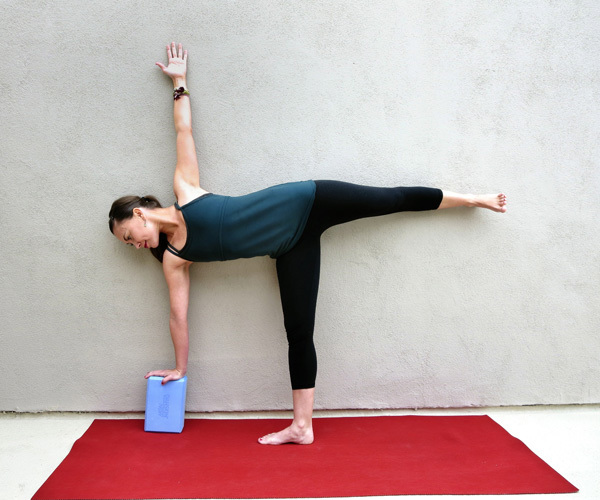 Mountain Pose (Tadasana)
Mountain Pose (Tadasana) Tadasana will teach you proper alignment that may help ward off new knee injuries and help you become aware of the muscles you need to engage to protect the knee. To get into the pose, stand with your feet hip distance apart, lift all your toes up, spread them wide, and then rest them back down on the floor. Press into the floor with all four corners of the feet to evenly distribute the weight of the body. As you press into your feet, engage your calf muscles. Engage the quadriceps and internally rotate your inner thighs to widen your sits bones. Tuck your tailbone in, and engage the glutes. Tighten your abs. Pull your shoulders back and down. Make sure your shoulders are stacked over your hips and ankles. Lift your chin and pull it back slightly so it is parallel with the floor. Relax the muscles in your face. Take several deep breaths and notice the muscles you have engaged to create proper posture. Hold this pose for approximately 10 breaths.
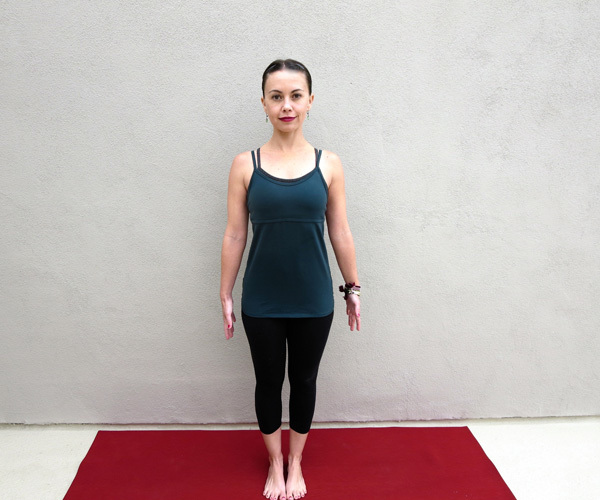 Triangle Pose (Trikonasana)
Triangle Pose (Trikonasana) A common problem with those who suffer with knee injuries or weakness is a strong
vastus lateralis (the outer part of your quadriceps) and a much weaker, underused
vastus medialis (the inner part of your quadriceps). Trikonasana is a pose that will strengthen the muscles that support the inner quad. Step your feet out in a wide stance so your left foot is parallel with the back of your mat and your right foot is turned out at a 90 degree angle, parallel with the inside horizontal edge of the mat. Bend your right knee so it lines up with the ankle and hip. Press into both feet and straighten the right leg, engaging the inner part of your quad and thigh. When this muscle is engaged, you will notice it is impossible to lock your knee. However, when you disengage the muscle, it will hyperextend and lock (you should avoid this). Reach your right arm straight down and rotate upward with the left side of your body. Line up your arms so they’re in a straight line and keep your core engaged. For support, you can place your right hand on a block, but be sure to keep the core engaged as you reach up to the sky with the left side of your body. Hold for a few breaths, disengage, and then repeat.
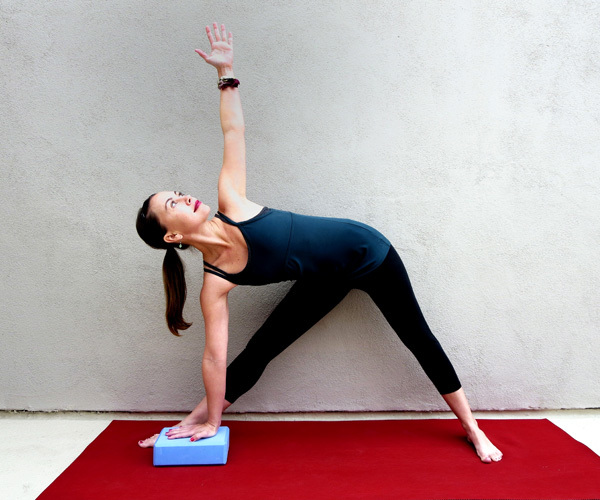 3 Knee Stretching Poses:
3 Knee Stretching Poses: It’s important to not only strengthen the knees but also to stretch them. You can make knee injuries worse if the muscles are so tight that they decrease movement fluidity. Here are 3 poses that stretch the knees and the supporting muscles without causing pain. Again keep in mind that each person is different and very few injuries are exactly the same, so make sure to seek advice from your physician before beginning.
Wide-Angled Seated Forward Bend (Upavistha Konasana) Many of the poses that stretch your legs and hips tend to torque the knee in a way that can be quite painful for those who have knee weakness and pain. Konasana is a great pose that will stretch out the whole back of the body as well as the hips, inner thighs, and groin. To get into this pose, straddle your legs out in the widest stance you can comfortably place them. Flex your feet to activate the leg muscles. Place your hands on the ground forward in front of you and slowly walk them forward until you feel the stretch. Keep your spine straight and elongated throughout the stretch. If you find that you spine creates a C shape when you start to fold, place a blanket under the sits bones to lift yourself slightly off the floor. Hold this pose for 8 to 10 breaths. Follow it up by pulling the legs together and the knees into the chest.
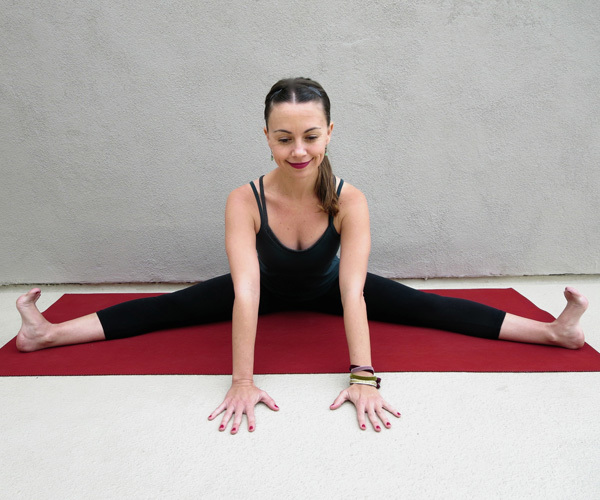 Easy Pose (Sukhasana)
Easy Pose (Sukhasana) Lotus is a common pose that that is held at the beginning and end of each yoga class and can be a real pain in the knee. So, instead of sitting with both feet in the crooks of your thighs, simply cross your legs and gently place one in front of the other. Keep in mind that the deeper the bend in the knee the higher the chance of pain, so you may not have a perfect crossed leg look. That’s okay. You also have the option of sitting on a blanket to make the pose more comfortable and placing blocks on either side of the knees. This pose will stretch your knees and ankles. Sit up tall and breathe deeply for about 8 to 10 breaths, increasing the amount of breaths as you feel more flexible over time.
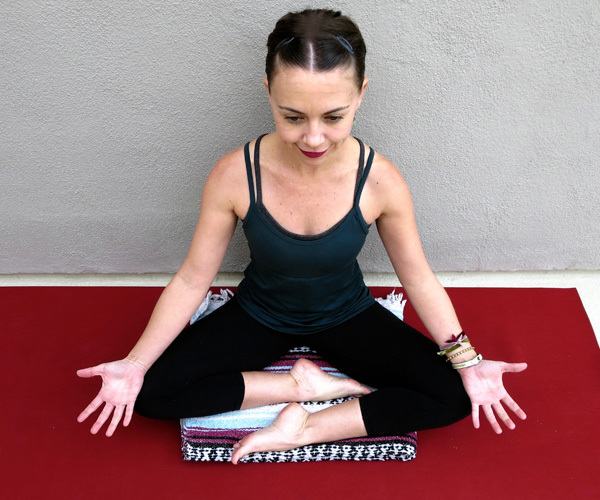 Child’s Pose (Balasana)
Child’s Pose (Balasana) This is a gentle knee stretch that can be intensified the closer you can move your bottom toward your heels. Props are necessary for those with tight, sore knees. Start on your hands and knees (with a blanket under the knees for protection). In the full, unmodified, pose you’d have your feet together with your toes untucked, knees separated so the belly can rest between the thighs, bottom sitting on the heels, and forehead on the mat with the arms extended out. Modify as you need. Consider decreasing the degree to which you part your knees. Use blankets behind the knees or on the heels. This pose can be held for 8 to 10 breaths and then increased slowly as you become more flexible.
